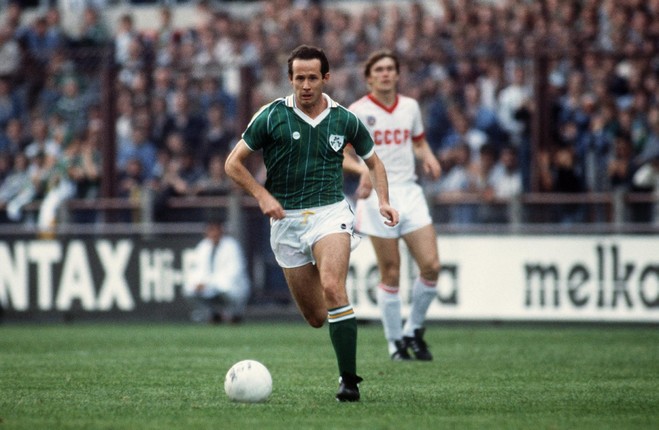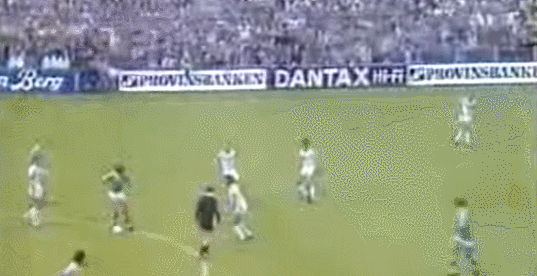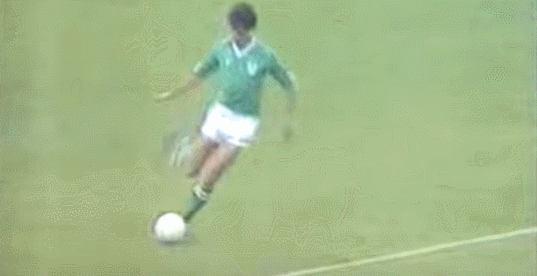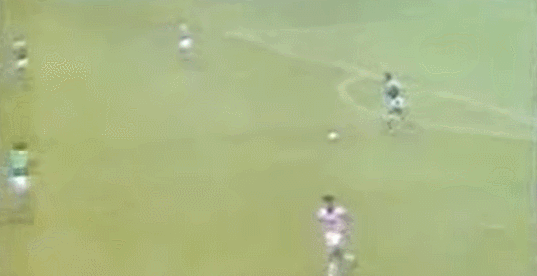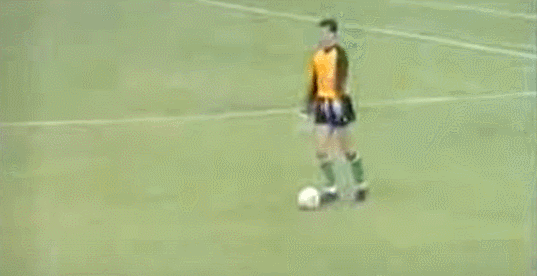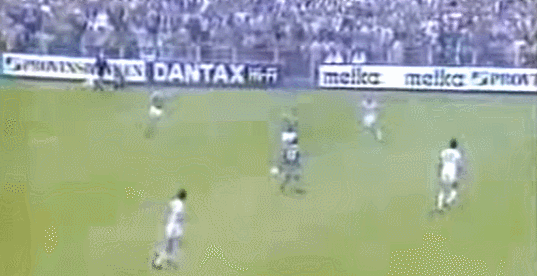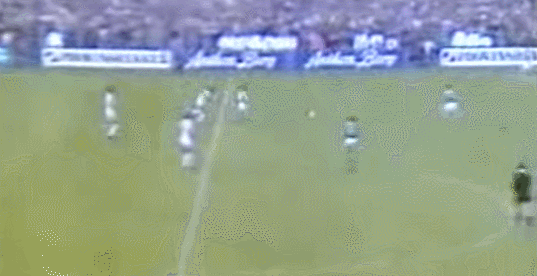IN RECENT WEEKS, there has been plenty of debate about the Irish team’s style of play and whether embracing good football in a technical sense is in the DNA of the country’s footballers.
Speaking on Newstalk recently, Richard Dunne suggested playing a long-ball, put-em-under-pressure game was in Irish footballers’ “DNA”.
Others, however, have disputed the claim. In The Irish Independent, former manager Brian Kerr wrote: “For me, Richard’s assessment was way too loose, and an unfair reflection of his experience under Mick McCarthy, whose teams played good, sensible football with Roy Keane at the heart of everything they did, given considerable help by the energy and excitement provided by a young Robbie Keane and a young Damien Duff.”
Meanwhile, RTÉ pundit and former Ireland international Eamon Dunphy has also suggested a more positive brand of football had been associated with the side until Jack Charlton took charge.
Of course, there have also been periods of a somewhat more ambitious style between the Charlton era and the present day (as Kerr points out). Niall Quinn may have been a key player for Ireland during the Mick McCarthy era, but the team were invariably able to get the ball down and play, even without a world-class midfielder like Keane in the team.
A case in point was the 2002 World Cup — even against top teams, Ireland were able to control the ball. Against Germany and Spain, the Boys in Green had 58% and 55% of the ball respectively.
In the subsequent years, there were also attempts to keep the ball on the ground, though as with McCarthy, Brian Kerr and Steve Staunton mixed patient build-up play with a more direct game. Andy Reid and Damien Duff were accommodated during this era, but so was Gary Doherty — a target man in the mould of a Quinn or a Cascarino, who obviously would not have looked out of place in a typical Charlton side.
Of course, the lack of success following McCarthy’s stint meant the Irish team ultimately began in some ways emulating the football of the Charlton era under Giovanni Trapattoni, and while it was not on the Italia ’90 scale, the approach brought a degree of success with the team’s Euro 2012 qualification.
Martin O’Neill has not stuck as rigidly to the long-ball game as Jack Charlton and Giovanni Trapattoni, with technical players such as Robbie Brady and Wes Hoolahan trusted at least to an extent.
That said, Ireland have rarely been pretty to watch under O’Neill — something acknowledged but also justified by James McClean after the Georgia game.
Both McClean and O’Neill hit back at critics saying that Ireland were never going to “wipe the floor” with teams, but — as Dunphy pointed out earlier this week — no one is really arguing they should be. Although the results have been positive, the performances have been less than convincing, and there remains a wish that the team could play in a more constructive fashion and with the team’s most creative player, Wes Hoolahan, afforded as much game time as possible.
Even in this Irish side’s best moment, the win over Italy at Euro 2016, it was more Jack Charlton than John Giles. In that game, the team managed just 225 completed passes – considerably less than they even produced against Moldova (288) or Georgia (276).
But going back to the claims made by Dunphy and Kerr, there has been much debate about whether the Irish team did ever play genuinely technical football in the manner that great teams such as Barcelona, and even less acclaimed sides such as Dundalk and Bournemouth, tend to play today.
- Soviet Union game
To get insight on how the Irish side played prior to the Charlton era, we revisited a game in the final qualification attempt before the 1966 World Cup winner took over.
Ireland’s opening match of the 1986 World Cup qualifying campaign was against the Soviet Union at Lansdowne Road.
At the time, the Soviets were a formidable force. They had qualified for the previous World Cup, and would go on to reach the last-16 of the 1986 World Cup. Moreover, when they came to Dublin in front of a crowd of approximately 38,000, they had lost just two of their previous 38 games. They also had Oleh Blokhin, who was the 1975 Ballon d’Or winner, in their team.
And watching the match back, the ‘good football’ claim largely does stand up. The Irish team that day was as follows: Seamus McDonagh; John Devine, David O’Leary, Mark Lawrenson, Chris Hughton, Ronnie Whelan, Tony Grealish, Liam Brady, Tony Galvin; Mickey Walsh, Michael Robinson.
There were shades of the Jack Charlton ‘put-em-under-pressure’ style with Soviet defenders regularly pressed deep in their own half (see pic below).
Yet the team were largely a good footballing side who seldom went long, with the clip below being one of the many examples of their attempts to pass the ball out from the back.
Liam Brady was at the heart of most of the best attacking moves, as he dictated play from the middle of the field, though other players such as Ronnie Whelan and Tony Grealish were also technically accomplished. In addition, there were no players in the mould of Glenn Whelan and James McCarthy who were reluctant to receive the ball in tight spaces.
There was an element of patience to the team’s play that was a stark contrast to the more manic approach adopted by the side just two years later when Charlton took charge.
One significant advantage that the Irish team of that era had over their present day counterparts was the presence of two footballing centre-backs in the team.
Both David O’Leary and Mark Lawrenson were comfortable with the ball at their feet and often started attacks. Nowadays, a ball-playing defender like Man City and England’s John Stones is a considerable anomaly, but in the 1980s, Ireland had two players in a similar mould. Watch below as O’Leary plays a one-two with Brady and actually starts a promising attack.
Consequently, for the most part, the team had a philosophy to pass the ball and almost never hit aimless long hoofs. There were, however, two instances in the second half, with the crowd growing anxious given that the score was still 0-0, where goalkeeper Seamus McDonagh opted to lump it long, but they were the exceptions rather than the rule.
Ireland played a traditional 4-4-2 style back then. Brady in particular was capable of carrying the ball and dribbling past a player, while there was plenty of emphasis on wing play. Both Tony Galvin and Ronnie Whelan would often try to take on the full back and whip in a cross, while Michael Robinson did likewise for the only goal of the game scored by Micky Walsh (see below).
Ireland clearly don’t have a player of the calibre of Liam Brady in their team at the moment, but Wes Hoolahan is undoubtedly the closest comparison, given that the Norwich man is the main creative outlet for the current Irish side.
Like Hoolahan, Brady frequently took risks in possession, playing a difficult pass or trying to beat his man, and of course, it didn’t always come off.
The big difference is that Brady was playing in the James McCarthy position. In modern football, it’s rare enough for a creative player like Brady to occupy a deep-lying position. Xavi and Santi Carzola are two examples, but for the most part in the Premier League in particular, a team’s main creative outlet tends to play out wide or behind the striker – Christian Eriksen, David Silva and Phillipe Coutinho are three prime examples.
Managers in the modern game presumably consider it too big a risk to play a creative player deep in midfield. As a consequence, more solid-but-unspectacular footballers like Glenn Whelan and James McCarthy, or in England’s case, Eric Dier and Jordan Henderson, tend to occupy the middle of the pitch.
These players’ main task is to win the ball back and not give it away, so they generally tend to pass it backwards or sideways. You would surely never see Glenn Whelan or James McCarthy be able or willing to execute a pass such as this one by Brady…
There were a few signs of the present-day Ireland during the Soviet Union game. Particularly in the dying minutes of the match, with the win in sight, and composure on one or two occasions deserting normally skillful players such as Ronnie Whelan below.
For the most part though, Ireland in this instance succeeded with a positive brand of football that was quite pleasing on the eye, even if there were occasional elements of the pragmatism and aggression that dominated the Charlton era.
So what went wrong thereafter?
Despite this positive start, Ireland’s qualification campaign ultimately fell apart. They would win just one more game, and finish second from bottom in a group that also featured Denmark, Switzerland and Norway. Eoin Hand stepped aside as a result.
This outcome is perhaps also part of the reason why the pretty football encouraged by Hand and Giles before him ultimately did not last. Football is a results-oriented business ultimately, and wins matter more than style, as McClean and O’Neill have argued of late.
It’s hard to say exactly why Ireland failed under Hand, though a lack of top-class player up front probably didn’t help. Ireland’s two strikers against the Soviets that day, Walsh and Robinson, were not prolific scorers at international level, managing just seven goals in 45 appearances between them. Even though a more acclaimed frontman in the form of Man United’s Frank Stapleton came into the side later on in the campaign, it was generally agreed that the squad never had any proper depth until the Charlton years.
They were also a little unlucky on more than one occasion, most notably when a late goal and a questionable refereeing call meant they missed out on the 1982 World Cup on goal difference.
Perhaps, if Ireland had enjoyed better fortune and qualified for Spain ’82, they would have had the confidence to persevere with a more enterprising style of football in subsequent years. Whether they would have enjoyed the same level of success is another matter, however.
Watch the full 1984 Ireland-Soviet Union match here…
Ireland: McDonagh; Devine, O’Leary, Lawrenson, Hughton; Whelan, Grealish, Brady, Galvin; Walsh, Robinson.
Soviet Union: Dasayev; Sulakvelidze, Chivadze, Baltacha, Aleinikov; Demianenko, Bessonov, Litovchenko, Oganesian; Blokhin, Rodionov.
The42 is on Snapchat! Tap the button below on your phone to add!
